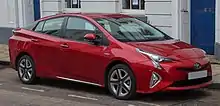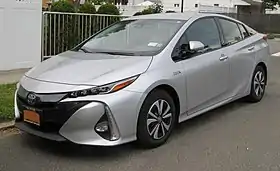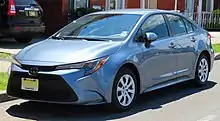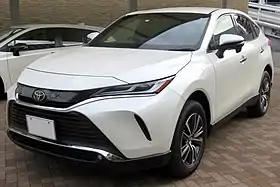Toyota New Global Architecture
The Toyota New Global Architecture (abbreviated as TNGA) are modular unibody automobile platforms that underpin various Toyota and Lexus models starting with the fourth-generation Prius in late 2015.[1] TNGA platforms accommodate different vehicle sizes and also front-, rear- and all-wheel drive configurations.[2]
| Toyota New Global Architecture | |
|---|---|
_Hybrid_liftback_(2016-04-02)_01.jpg.webp) Fourth-generation Toyota Prius, the first vehicle to use the Toyota New Global Architecture platform | |
| Overview | |
| Manufacturer | Toyota |
| Production | 2015–present |
| Chronology | |
| Predecessor |
|
The platforms were developed as part of a company-wide effort to simplify the vehicles being produced by Toyota. Before the introduction of the TNGA, Toyota was building roughly 100 different platform variants.[3] As of 2020, the five TNGA platforms underpin more than 50% of Toyota vehicles sold worldwide and is expected to underpin about 80% by 2023.[4]
Each platform is based on a standardized seat height that allows for sharing of key interior components such as steering systems, shifters, pedals, seat frames and airbags.[5] These components are often less visible, allowing for cars that share platforms to have unique interiors. Compared to Toyota's older platforms, TNGA costs 20 percent less to produce while offering increased chassis stiffness, lower centers of gravity for better handling and lower hood cowls for better forward visibility.[3]
The TNGA platform was developed alongside the Dynamic Force engine, which similarly is replacing more than 800 engine variants with a much simpler lineup of 17 versions of nine engines.[3] Toyota is also simplifying its lineup of transmissions, hybrid systems, and all-wheel drive systems.
Applications
TNGA-B (GA-B)
The TNGA-B platform underpins vehicles in the B-segment (Europe) or subcompact car (America), and subcompact crossover SUV categories. The platform is offered in both front-wheel drive and all-wheel drive variants and is paired with a transverse engine.[6][7] TNGA-B replaces the older B platform.
Vehicles using platform (calendar years):
- Toyota Yaris — XP210 (2020–present)[8]
- Toyota GR Yaris — XP210 (2020–present; with the rear from GA-C platform)[9]
- Toyota Yaris Cross — XP210 (2020–present)[10]
 Toyota Yaris
Toyota Yaris)_front.jpg.webp) Toyota GR Yaris
Toyota GR Yaris_front.jpg.webp) Toyota Yaris Cross
Toyota Yaris Cross
TNGA-C (GA-C)
The TNGA-C platform underpins vehicles in the C-segment (Europe) or compact car (America), and subcompact/compact crossover SUV categories. The platform is offered in both front-wheel drive and all-wheel drive variants and is paired with a transverse engine. Currently, the platform supports wheelbase length of 2,640–2,750 mm (103.9–108.3 in). TNGA-C replaces the older MC/New MC platform.
Vehicles using platform (calendar years):
- Toyota Prius — XW50 (2015–present)[11]
- Toyota Prius Plug-in Hybrid/Prime — XW50 (2016–present)[12]
- Toyota C-HR/IZOA — AX10 (2016–present)[13]
- Toyota Corolla — E210 (2018–present)
- Toyota Allion — E210 (2020–present)
- Toyota Auris — E210 (2018–2020)[14]
- Toyota Levin — E210 (2019–present)
- Suzuki Swace — E210 (2020–present)
- Toyota Corolla Cross — XG10 (2020–present)[15]
- Lexus UX — ZA10 (2018–present)[16]
 Toyota Prius
Toyota Prius Toyota Prius Prime
Toyota Prius Prime_Koba_AWD_hatchback_(2018-08-27)_01.jpg.webp) Toyota C-HR
Toyota C-HR Toyota Corolla sedan (Sporty)
Toyota Corolla sedan (Sporty) Toyota Corolla sedan (Prestige)
Toyota Corolla sedan (Prestige).jpg.webp) Toyota Levin GT
Toyota Levin GT.jpg.webp) Toyota Allion
Toyota Allion_Ascent_Sport_hatchback_(2018-11-02)_01.jpg.webp) Toyota Corolla hatchback
Toyota Corolla hatchback_IMG_2661.jpg.webp) Toyota Corolla Touring Sports
Toyota Corolla Touring Sports.jpg.webp) Toyota Corolla Cross
Toyota Corolla Cross Lexus UX
Lexus UX
TNGA-K (GA-K)
The TNGA-K platform underpins vehicles in the D-segment/E-segment (Europe) or mid-size/full-size car (America), and compact/mid-size crossover SUV categories. The platform is offered in both front-wheel drive and all-wheel drive variants and is paired with a transverse engine. Currently, the platform supports a wheelbase length of 2,690–3,060 mm (105.9–120.5 in). TNGA-K replaces the older K platform.
Vehicles using platform (calendar years):
- Toyota Camry/Daihatsu Altis — XV70 (2017–present)[17]
- Toyota Avalon — XX50 (2018–present)[18]
- Toyota RAV4 — XA50 (2018–present)[19][20][21]
- Toyota Wildlander — XA50 (2019–present)
- Suzuki Across — XA50 (2020–present)
- Toyota Highlander/Kluger — XU70 (2019–present)[22][23][24]
- Toyota Harrier/Venza — XU80 (2020–present)[25][26]
- Toyota Sienna — XL40 (2020–present)[27]
- Lexus ES — XZ10 (2018–present)[28]
_Ascent_sedan_(2018-08-27)_01.jpg.webp) Toyota Camry
Toyota Camry_01.png.webp) Toyota Avalon
Toyota Avalon Toyota RAV4
Toyota RAV4_6.6.20.jpg.webp) Toyota Highlander
Toyota Highlander Toyota Harrier
Toyota Harrier Toyota Sienna
Toyota Sienna Lexus ES
Lexus ES
TNGA-L (GA-L)
The TNGA-L platform underpins vehicles in the F-segment/S-segment (Europe) or full-size luxury car/grand tourer (America) categories. The platform is offered in both rear-wheel drive and all-wheel drive variants and is paired with longitudinal engine. Along with TNGA-N, TNGA-L replaces the older N platform.
Vehicles using platform (calendar years):
- Lexus LC — XZ100 (2017–present)[29]
- Lexus LS — XF50 (2017–present)[29]
- Toyota Mirai — JPD20 (2020–present)[30]
 Lexus LC
Lexus LC Lexus LS
Lexus LS_with_the_factory-installed_option.jpg.webp) Toyota Mirai
Toyota Mirai
TNGA-N (GA-N)
The TNGA-N platform underpins vehicles in the E-segment (Europe) or full-size car (America) categories. The platform is offered in both rear-wheel drive and all-wheel drive variants and is paired with a longitudinal engine. Along with TNGA-L, TNGA-N replaces the older N platform.
Vehicles using platform (calendar years):
- Toyota Crown — S220 (2018–present)[31]
 Toyota Crown
Toyota Crown
e-TNGA
The e-TNGA is an electric car platform that will be applied to 10 dedicated models worldwide (including 6 global models) by early 2020. The six global models include:
- Compact car (in collaboration with Suzuki and Daihatsu)
- Mid-size crossover SUV
- Mid-size sedan
- Minivan
- Mid-size SUV (in collaboration with Subaru)
- Large SUV
The platform will enable offering various type and size of vehicles, different battery capacity and with front-wheel drive, rear-wheel drive or dual motor all-wheel drive. This vehicle architecture is partitioned into five modules. These are the front module, center module, rear module, battery and motor. Up to three versions of each module are in development, including three capacities for the lithium-ion battery.[32][33][34]
References
- Stocklosa, Alexander (27 March 2015). "Cowa-TNGA! Toyota's New Modular Platform Reaching Production This Year". Car and Driver. Retrieved 5 August 2016.
- Akita, Masahiro (11 March 2013). "Opportunities and risks related to parts sourcing for next-gen Prius". Credit Suisse. pp. 1–3. Archived from the original on 17 July 2014.
- Reynolds, Kim (7 May 2015). "How the Toyota New Global Architecture Will Impact Mass-Car Building". Motor Trend. Retrieved 24 August 2020.
- "Features of Toyota's New Powertrain". Toyota Motor Corporation. Retrieved 24 August 2020.
- Lin, Kelly (27 March 2015). "Toyota New Global Architecture to Debut This Year, Likely on the New Prius". Motor Trend. Retrieved 24 August 2020.
- Bruce, Chris (5 September 2019). "Toyota Announces New TNGA Small Car Platform, Likely For Next-Gen Yaris". Motor1. US. Retrieved 9 October 2019.
- "Toyota Brings TNGA To Small Cars With New GA-B Platform" (Press release). Europe: Toyota. 5 September 2019. Retrieved 9 October 2019.
- "Toyota's New Model Yaris Makes World Premiere" (Press release). Toyota. 16 October 2019. Retrieved 21 December 2019.
- "Toyota GR Yaris officially revealed". Motoring. Australia. 10 January 2020. Retrieved 15 January 2020.
- "Toyota's Yaris Cross Makes World Debut" (Press release). Toyota. 23 April 2020. Retrieved 23 April 2020.
- Dowling, Neil (8 March 2016). "Driven: Reset for Toyota's Prius hybrid king". GoAuto. Retrieved 14 March 2016.
- White, Annie (December 2017). "2018 Toyota Prius Prime | In-Depth Model Review". Car and Driver. US. Retrieved 30 May 2018.
- Ogbac, Stefan (8 March 2016). "Report: Toyota C-HR moved to TNGA platform midway through development". Motor Trend. Retrieved 14 March 2016.
- "New Auris" (Press release). Geneva: Toyota Europe. 6 March 2018. Retrieved 9 March 2018.
- Lye, Gerard (9 July 2020). "2020 Toyota Corolla Cross debuts in Thailand – TNGA platform; petrol and hybrid powertrains; from RM132k". Paultan.org. Malaysia: Driven Communications. Retrieved 9 July 2020.
- "World Debut of the Lexus UX, a New Genre of Crossover" (Press release). Japan: Toyota. 6 March 2018. Retrieved 9 March 2018.
- Booth, David (10 January 2017). "Toyota Camry redesigned for 2018 – and it actually looks good". Driving. Retrieved 10 January 2017.
- "Attainable Premium, Actualized: All-New 2019 Toyota Avalon Beams Effortless Sophistication, Style, and Exhilaration at the 2018 North American International Auto Show" (Press release). US: Toyota. 15 January 2018. Retrieved 30 May 2018.
- "Toyota Service Information – What's new?". Europe: Toyota. 19 January 2019. Retrieved 19 February 2019.
- "All-New 2019 Toyota RAV4 Serves Up A Breakthrough Debut At New York International Auto Show" (Press release). US: Toyota. 28 March 2018. Retrieved 10 May 2018 – via PR Newswire.
- "The RAV4 Plug-in Hybrid, Toyota's new hybrid flagship" (Press release). Brussels: Toyota Europe Newsroom. 14 January 2020. Retrieved 30 April 2020.
- "World Premiere of All-New 2020 Highlander at New York International Auto Show" (Press release). US: Toyota. 17 April 2019. Retrieved 17 April 2019.
- Wendler, Andrew (17 April 2019). "The 2020 Toyota Highlander Is a More Chiseled Version of Itself". Car and Driver. US. Retrieved 17 April 2019.
- Dowling, Joshua (11 May 2020). "Toyota Kluger Hybrid confirmed for Australia". CarAdvice. Australia. Retrieved 6 December 2020.
- "Toyota to Unveil New Model Harrier in Japan" (Press release). Toyota City, Aichi: Toyota Global Newsroom. 13 April 2020. Retrieved 13 April 2020.
- Chan, Mick (13 April 2020). "All-new 2020 Toyota Harrier debuts – TNGA (GA-K) platform, 2.0L petrol, Direct Shift-CVT, no more turbo". Paultan.org. Malaysia: Driven Communications. Retrieved 13 April 2020.
- Perez, Jeff. "2021 Toyota Sienna Debuts With Standard Hybrid Powertrain, Bold Looks". Motor1.com. Retrieved 18 May 2020.
- "The all-new Lexus ES: a higher level of performance and sophistication" (Press release). Automotive World. 25 April 2018. Retrieved 25 April 2018.
- "New Lexus LS Flagship Sedan to Make Global Debut at the 2017 NAIAS" (Press release). US: Toyota. 8 December 2016. Retrieved 22 December 2016.
- "New Mirai hydrogen fuel cell electric vehicle - under the skin". UK: Toyota. 30 November 2020. Retrieved 6 December 2020.
- "トヨタのTNGAとはプラットフォームのこと? | 気になる車をクローズアップ" [What is Toyota's TNGA platform? Close up of the car you care about] (in Japanese). Japan: Toyota. 5 May 2018. Retrieved 17 July 2018.
- Kane, Mark (7 June 2019). "Toyota Goes Electric Starting In 2020: Announces Massive EV Offensive". InsideEVs. US. Retrieved 9 June 2019.
- Panait, Mircea (8 June 2019). "New Toyota e-TNGA Platform Detailed, Every Model Will Be Electrified By 2025". autoevolution. Romania. Retrieved 9 June 2019.
- "Toyota's Challenge – Aiming to Popularize BEVs" (PDF) (Press release). Toyota. 7 June 2019. Retrieved 15 January 2020.
External links
| Wikimedia Commons has media related to Toyota New Global Architecture. |
- Official website (global)